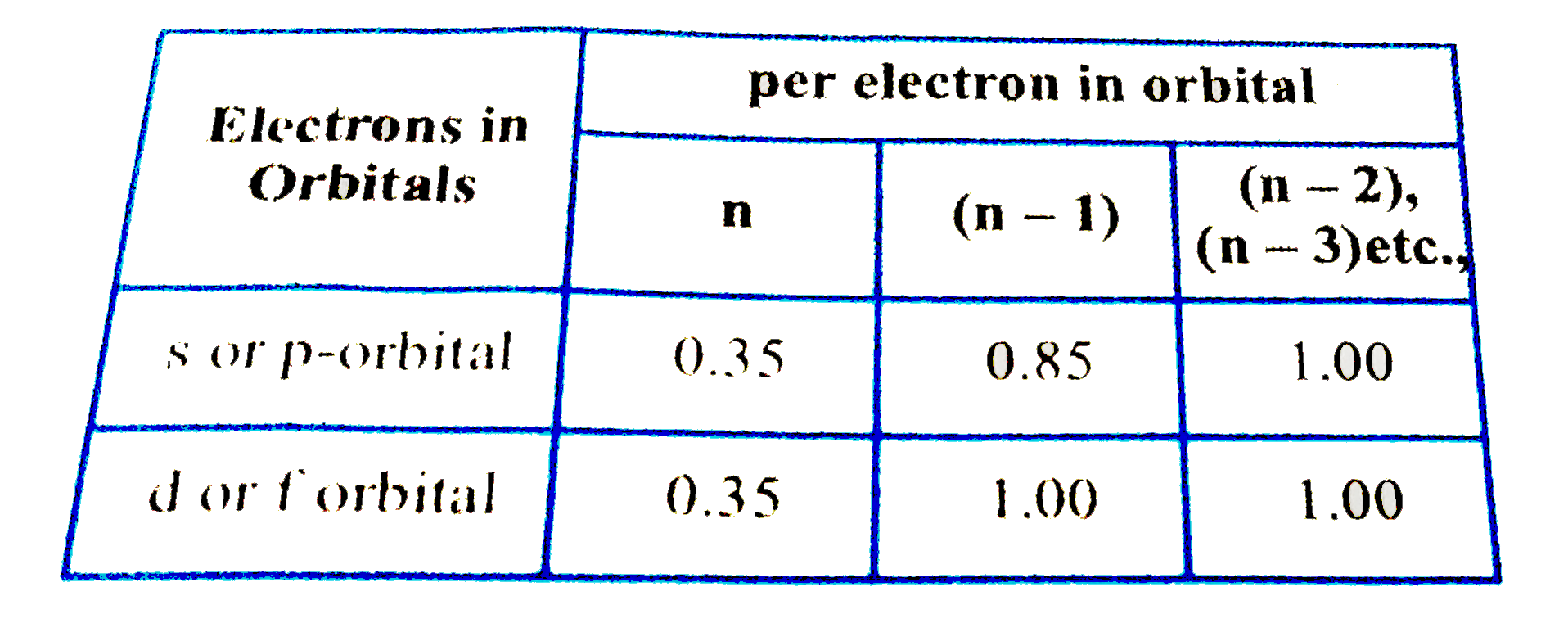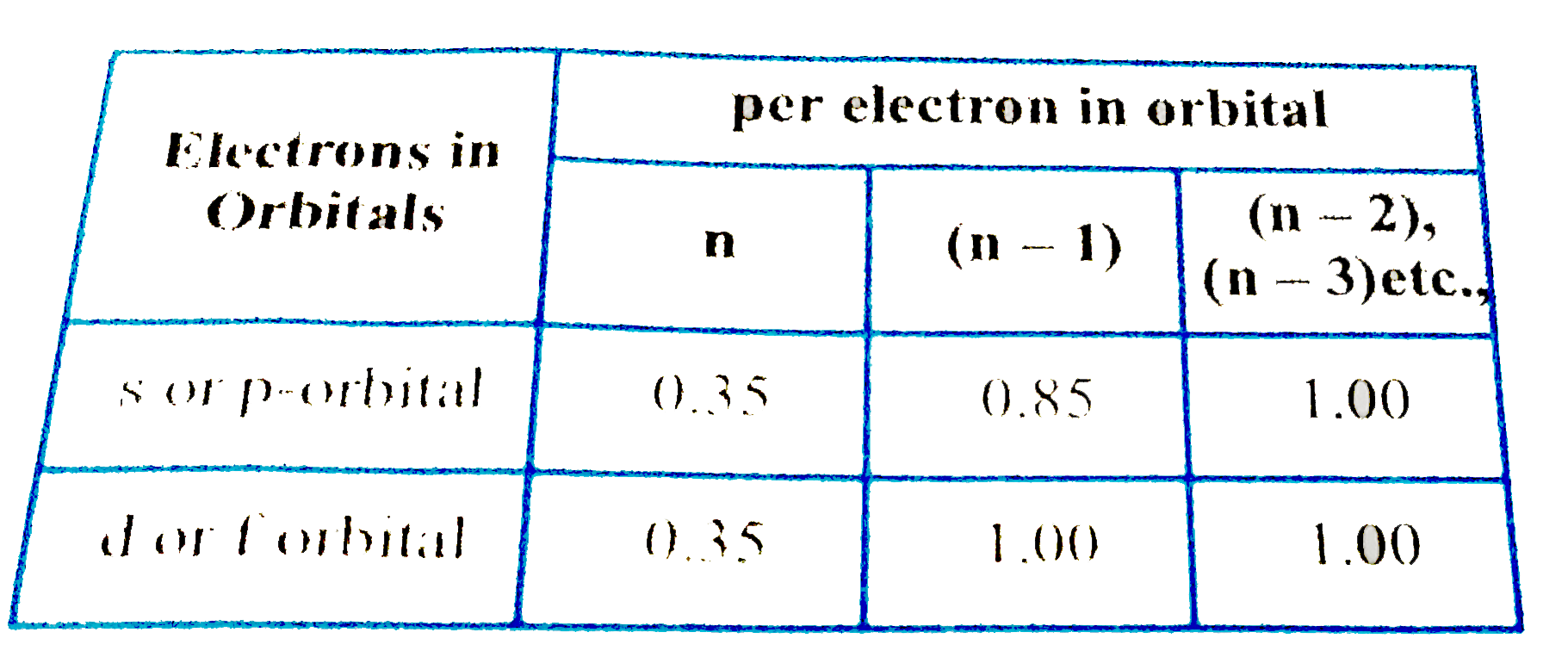According to I.C slater effective nuclear charge, Z∗, due to screening, is not exactly equal to the actual nuclear charge Z of the nucleus of the atom. Z∗ depends on the type of orbitals in which the electron is housed, and on the ability of other electrons in more penetrating orbitals to screen the electron in question from the nucleus.
The relative extent to which the various orbitals penetrate the electron clouds of other orbitals is s>p>f . The effective nuclear charge Z∗ due to screening is given by Z∗=Z−σ, where Z is the atomic atomic number and σ is the slater screening constant values 0<σ<Z

Screening effect of one electron in the outermost orbitals, is not considered in calculate of σ.
In which of the following cases the concept of Z∗ is applicable?
Ionisation energy increases as Z∗ increases
Electronegativity of the atom increases as Z∗ increases
The ionisation energy of Na,K−,Rb− , are comparable because of equal Z∗
All of the above
The correct Answer is:C
Step by step video, text & image solution for According to I.C slater effective nuclear charge, Z^(**), due to screening, is not exactly equal to the actual nuclear charge Z of the nucleus of the atom. Z^(**) depends on the type of orbitals in which the electron is housed, and on the ability of other electrons in more penetrating orbitals to screen the electron in question from the nucleus. The relative extent to which the various orbitals penetrate the electron clouds of other orbitals is s gt p gt f . The effective nuclear charge Z^(**) due to screening is given by Z^(**)=Z-sigma, where Z is the atomic atomic number and sigma is the slater screening constant values 0 lt sigma lt Z Screening effect of one electron in the outermost orbitals, is not considered in calculate of sigma. In which of the following cases the concept of Z^(**) is applicable? by Chemistry experts to help you in doubts & scoring excellent marks in Class 12 exams.
Updated on:21/07/2023Topper's Solved these Questions
Similar Questions
The final products is the following sequenceof reaction is

View SolutionWhich of the following polymers of glucose is stored by animals?
View SolutionThe unpaired electrons in Al and Si are present in 3p orbital. Which electrons will experience more effective nuclear charge from the nucleus?
View SolutionAccording to I.C slater effective nuclear charge, Z∗, due to screening, is not exactly equal to the actual nuclear charge Z of the nucleus of the atom. Z∗ depends on the type of orbitals in which the electron is housed, and on the ability of other electrons in more penetrating orbitals to screen the electron in question from the nucleus.
The relative extent to which the various orbitals penetrate the electron clouds of other orbitals is s>p>f . The effective nuclear charge Z∗ due to screening is given by Z∗=Z−σ, where Z is the atomic atomic number and σ is the slater screening constant values 0<σ<Z

Screening effect of one electron in the outermost orbitals, is not considered in calculate of σ.
What is the value of Z∗ for Rb(37) ?
View SolutionAccording to I.C slater effective nuclear charge, Z∗, due to screening, is not exactly equal to the actual nuclear charge Z of the nucleus of the atom. Z∗ depends on the type of orbitals in which the electron is housed, and on the ability of other electrons in more penetrating orbitals to screen the electron in question from the nucleus.
The relative extent to which the various orbitals penetrate the electron clouds of other orbitals is s>p>f . The effective nuclear charge Z∗ due to screening is given by Z∗=Z−σ, where Z is the atomic atomic number and σ is the slater screening constant values 0<σ<Z

Screening effect of one electron in the outermost orbitals, is not considered in calculate of σ.
what is Z∗ for Cu(29) ?
View SolutionAccording to I.C slater effective nuclear charge, Z^(**) , due to screening, is not exactly equal to the actual nuclear charge Z of the nucleus of the atom. Z^(**) depends on the type of orbitals in which the electron is housed, and on the ability of other electrons in more penetrating orbitals to screen the electron in question from the nucleus. The relative extent to which the various orbitals penetrate the electron clouds of other orbitals is s gt p gt f . The effective nuclear charge Z^(**) due to screening is given by Z^(**)=Z-sigma , where Z is the atomic atomic number and sigma is the slater screening constant values 0 lt sigma lt Z Screening effect of one electron in the outermost orbitals, is not considered in calculate of sigma . What is the value of Z^(**) for Rb(37) ?
View SolutionNuclear charge actually experienced by an electron is termed as effective nuclear charge. The effective nuclear charge Z∗ actuall ydepends on type of shell and orbital in which electron is actually present. The relative extent to which the various orbitals penetrate the electron clouds of other orbitals is
s>p>d>f (for the same value of n)
The phenomenon in which penultimate shell electrons act as screen or sheild in between nucleus and valence shell electrons and thereby reducing nuclear charge is known as shielding effect. the penultimate shell electrons repel the valence shell electron to keep them loosely held with nucleus. it is thus evident that more is the shielding effect, lesser is the effective nuclear charge and lesser is the ionization energy.
Q. Which of the following valence electron experience maximum effective nuclear charge?
View SolutionJ.C. Slater proposed an empirical constant that represents the cumulative extent to which the other electrons of an atom shield (or screen) any particular electron from the nuclear charge. Thus, slater's screening contant sigma is as : Z^(**)=Z-sigma Here, Z is the atomic number of the atom, and hence is equal to the actual number of protons in the atom. the parameter Z^(**) is the effective nuclear charge, which according to is smaller than Z, since the electron in question is screened (shielded) from Z by an amount sigma . Conversely, an electron that is well shielded from the nuclear charge Z experiences a small effective nuclear charge Z^(**) . The value of sigma for any one electron in a given electron configuration (i.e., in the presence of the other electrons of the atom in question) is calculated using a set of empirical rules developed by slater. according to these rules, the value of sigma for the electron in question is the cumulative total provided by the various other electrons of the atom. Q. Which of the following statement is correct?
View SolutionThe unpaired electrons in Al and Si are present in 3p orbital. Which electrons will experience more effective nuclear charge from the nucleus?
View SolutionNuclear charge actually experienced by an electron is termed as effective nuclear charge. The effective nuclear charge Z^(**) actuall ydepends on type of shell and orbital in which electron is actually present. The relative extent to which the various orbitals penetrate the electron clouds of other orbitals is s gt p gt d gt f (for the same value of n) The phenomenon in which penultimate shell electrons act as screen or sheild in between nucleus and valence shell electrons and thereby reducing nuclear charge is known as shielding effect. the penultimate shell electrons repel the valence shell electron to keep them loosely held with nucleus. it is thus evident that more is the shielding effect, lesser is the effective nuclear charge and lesser is the ionization energy. Q. Which of the following valence electron experience maximum effective nuclear charge?
View SolutionNuclear charge actually experienced by an electron is termed as effective nuclear charge. The effective nuclear charge Z∗ actuall ydepends on type of shell and orbital in which electron is actually present. The relative extent to which the various orbitals penetrate the electron clouds of other orbitals is
s>p>d>f (for the same value of n)
The phenomenon in which penultimate shell electrons act as screen or sheild in between nucleus and valence shell electrons and thereby reducing nuclear charge is known as shielding effect. the penultimate shell electrons repel the valence shell electron to keep them loosely held with nucleus. it is thus evident that more is the shielding effect, lesser is the effective nuclear charge and lesser is the ionization energy.
Q. Which of the following is not concerned to effective nuclear charge?
View SolutionThe unpaired electrons in Al and Si are present in 3p orbital. Which electrons will experience more effective nuclear charge from the nucleus?
View SolutionThe unpaired electrons in AI and sI are present in 3p orbital . Which electron will experience more effective nuclear charge from the nucleus ?
View SolutionThe unparied electrons in Al and Si are in 3p orbital. Which electrons will experience more effective nuclear charge from the nucleus?
View SolutionNuclear charge actually experienced by an electron is termed as effective nuclear charge. The effective nuclear charge Z^(**) actuall ydepends on type of shell and orbital in which electron is actually present. The relative extent to which the various orbitals penetrate the electron clouds of other orbitals is s gt p gt d gt f (for the same value of n) The phenomenon in which penultimate shell electrons act as screen or sheild in between nucleus and valence shell electrons and thereby reducing nuclear charge is known as shielding effect. the penultimate shell electrons repel the valence shell electron to keep them loosely held with nucleus. it is thus evident that more is the shielding effect, lesser is the effective nuclear charge and lesser is the ionization energy. Q. Which of the following valence electron experience maximum effective nuclear charge?
View Solution
